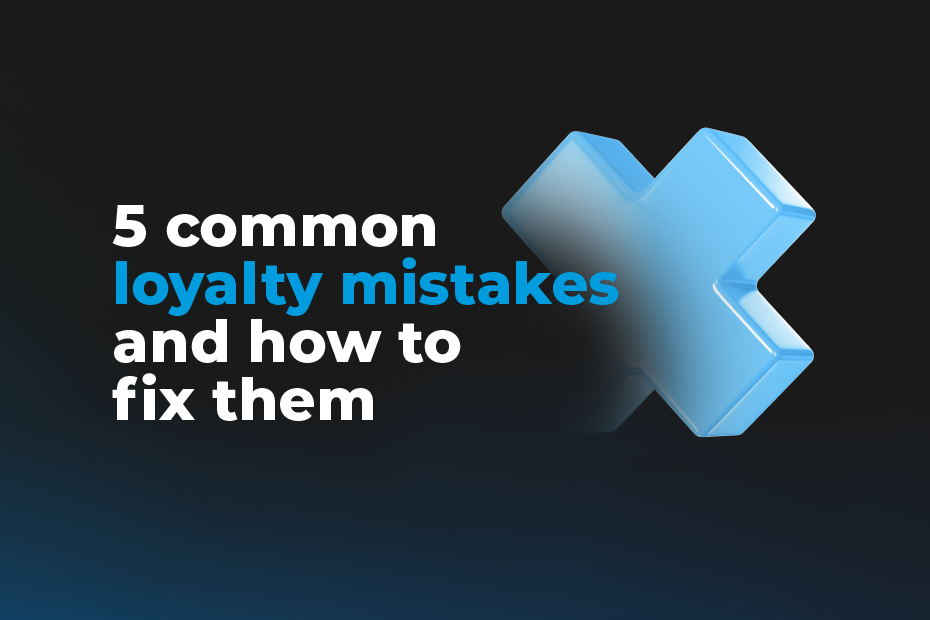Even the most well-intentioned loyalty programs can underperform. Brands invest in design, rewards, and promotions, yet members disengage, redemptions drop, and retention goals remain unmet. The issue isn’t the concept of loyalty itself, it’s how it’s built and managed.
Across industries, retailers make the same recurring mistakes: creating programs without customer input, relying on fragmented tech stacks, skipping onboarding, ignoring optimization, or exhausting members with repetitive rewards. Each misstep quietly erodes trust and profitability.
In this blog, we’ll uncover the five most common loyalty mistakes that limit growth and show how retailers can fix them using the right mix of data, personalization, and automation.
Mistake #1: designing without asking customers
Many loyalty programs start with good intentions but not with the customer. Retailers often build programs based on internal assumptions, competitor strategies, or outdated mechanics. The result is a loyalty experience that looks strong in concept but fails to connect emotionally or practically with members.
To design effectively, brands must start from real customer behavior. As explained in The 7 Stages of Loyalty Program Maturity, early-stage programs often miss this critical insight, while mature ones rely on segmentation and data-driven personalization.
The fix lies in behavioral analytics and RFM segmentation. Platforms like Loymax turn CRM data into actionable insights, helping retailers design programs around motivations, not assumptions. By analyzing CLTV and purchase frequency, businesses can align their loyalty structures with what truly drives retention.
Mistake #2: choosing the wrong tech stack
Even the most creative loyalty idea fails without the right technology behind it. Many retailers still use outdated systems that don’t talk to each other, leaving customer data fragmented across e-commerce, POS, and mobile apps.
As we discussed in Still Managing Data Manually? Discover the Power of Micro-Moments, manual data management slows down personalization and causes inconsistencies across campaigns.
To fix this, retailers need an integrated CRM and marketing automation engine that unifies every touchpoint. Loymax enables this through data integration, real-time updates, and smart communications – ensuring customer experiences are connected and consistent.
When brands build their loyalty infrastructure on the right foundation, every point earned, promo code redeemed, and campaign launched feels synchronized – not siloed.
Mistake #3: poor onboarding
The first 30 days of a loyalty journey often determine long-term participation. Yet, many brands overlook this stage, offering generic welcomes or unclear earning mechanics.
Strong onboarding builds confidence, excitement, and understanding. Retailers should educate members about rewards, send personalized welcome offers, and provide quick-win challenges that demonstrate value early.
In Loymax Loyalty Solutions for Every Retail Industry, we explored how onboarding differs across sectors – from retail to fuel and pharma – but the principle is always the same: simplify the first experience.
With Loymax, retailers can automate onboarding flows that greet, guide, and reward customers intelligently. From welcome bonuses to AI-powered tips, every message helps customers understand how to earn and redeem effortlessly.
Mistake #4: no testing or optimization
Launching a loyalty program is just the beginning but not the end. Too often, brands fail to revisit data, leaving their programs static and unresponsive.
Optimization means using A/B testing, cohort analysis, and feedback loops to continually refine rewards, communications, and campaign frequency. In our Case Study: How a Large Fuel Retailer Transformed Loyalty with Loymax, real-time testing and dynamic rewards directly improved customer retention.
Through Loymax’s BI dashboards and automation solutions, retailers can test multiple variants at once without coding. Insights from these tests help brands refine offers, adjust triggers, and improve AOV over time.
Testing isn’t just a technical process, it’s how loyalty evolves from transactional to emotional.
Mistake #5: reward fatigue
When every campaign feels predictable, loyalty engagement declines. Customers get tired of earning the same points or redeeming repetitive discounts – a common symptom of reward fatigue.
To combat this, retailers need creativity and data. In The Power of Omnichannel Loyalty: A Customer Journey Approach, we showed how cross-channel engagement – such as in-store QR rewards, mobile challenges, and email triggers – keeps customers excited.
Similarly, AI-driven personalization in Loymax allows brands to deliver unique, timely incentives that match each customer’s behavior. Gamified experiences, surprise bonuses, and non-monetary rewards can re-energize participation while improving customer retention and CLTV.
Reward fatigue isn’t a sign of failure, it’s a signal to innovate.
Turning mistakes into momentum
Loyalty mistakes are valuable lessons in disguise. Each one reveals how customers interact, what they value, and where programs can improve.
As shown in Measure What Matters With Real-Time Analytics, retailers that monitor loyalty ROI through retention, frequency, and spend – not just point redemption – consistently outperform competitors.
By learning from these missteps and adopting an integrated, customer-first approach, brands can transform loyalty from a tactical add-on into a long-term growth strategy.
Conclusion
Every loyalty program carries potential, but success depends on avoiding these five pitfalls: ignoring customer feedback, using fragmented systems, weak onboarding, lack of optimization, and stale rewards.
Loymax helps retailers overcome each of these challenges by combining CRM marketing automation, data analysis, and omnichannel engagement in a single, no-code platform.
Get a free consultation to see how Loymax helps brands avoid these loyalty pitfalls.
Contact us today.

